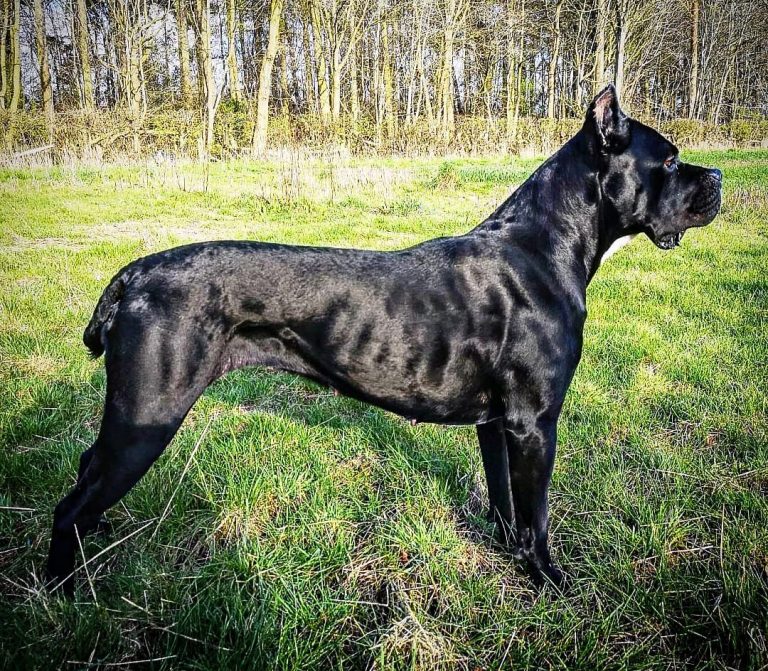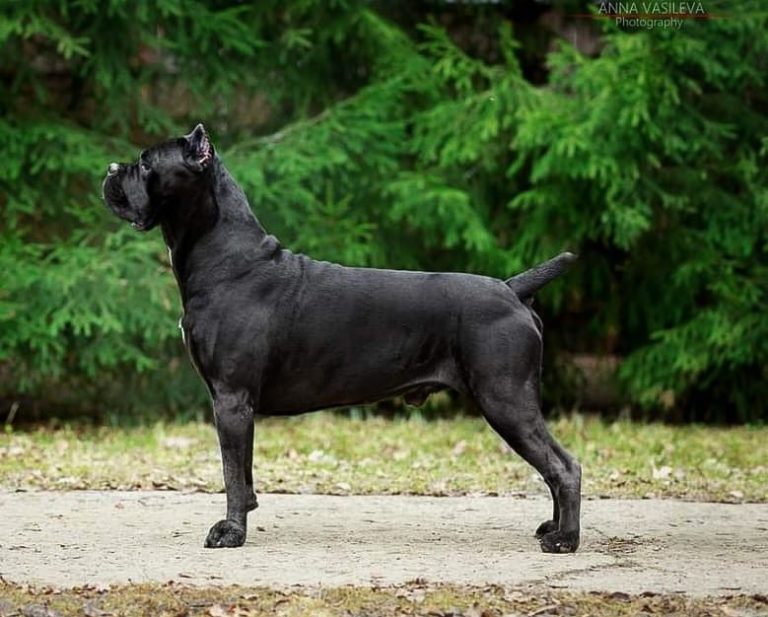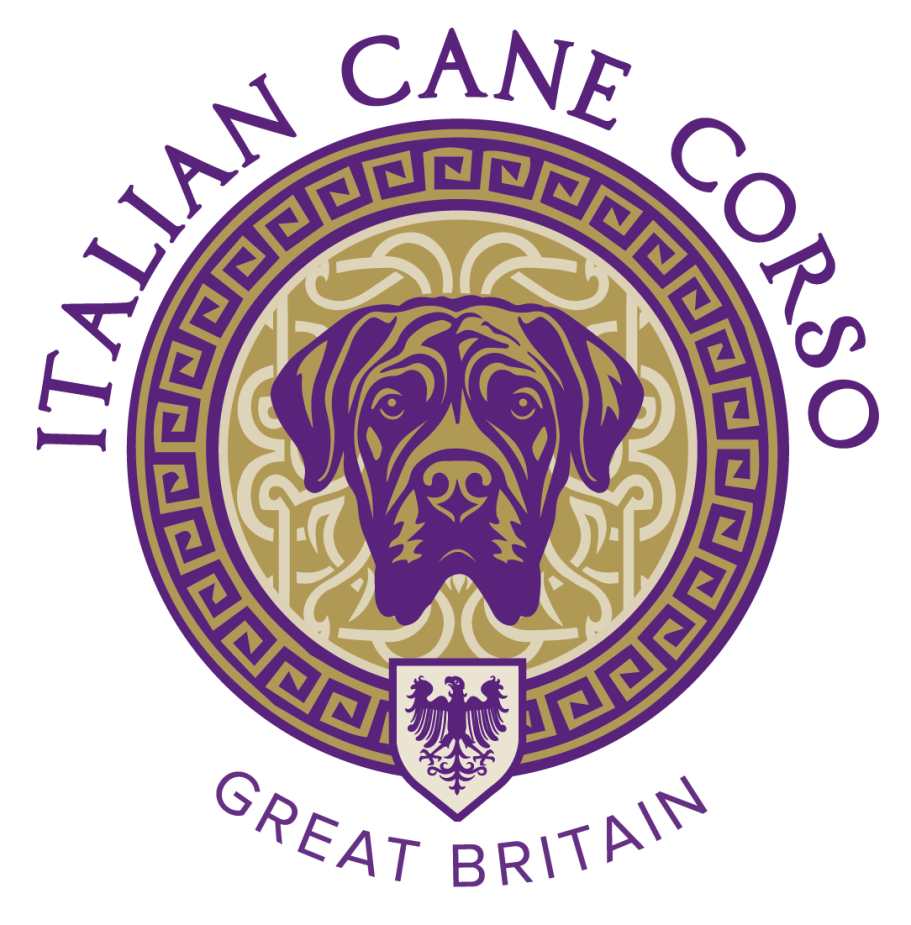Our Breed Standard
In Italian: Cane Corso Italiano
In English: Italian Cane Corso, Italian Mastiff
Standard derived from the globally accepted FCI Breed Standard
Classification: FCI Group 2 Section 2.1 Molossoid; Mastiff type. AKC Working. Intended KC Group Working.
Size and Weight: From 23”/60cm in females and from 25”/64cm in males. No upper bound, the overall structure of the dog is in balance. Weight should be in proportion to the dog.
Historical Summary (derived from FCI standard): Its direct ancestor is the old Roman Molossian. Formerly scattered all over Italy, in the recent past, the breed was only prevalent in the province of Apulia and in the adjacent regions of Southern Italy. His name derives from the Latin “cohors”, which means “protector, guardian of the farmyard”. Cane Corso has been used as a guardian, livestock droving dog, hunting dog and dedicated companion for many decades, originating from Southern Italy.
General Impression
A large dog with a commanding presence and formidable expression. Surprisingly elegant in movement, yet structurally capable and vigilant, a working and guarding breed first and foremost.
Important Proportions
The dog is rectangular in outline and is slightly longer than tall. (The length of the dog is 11% greater than the height of the dog). The length of the head reaches 36 % of the height at the withers.
Temperament
First and foremost, the Cane Corso is a dedicated close quarter guardian dog. Balanced in nature, the dog should be aloof to strangers but accepting and affectionate with family. Dignified in essence, the Cane Corso should be courageous and able to think independently, is an adept problem-solver, and enjoys training and work. Some degree of same sex aggression may be accepted, but not favoured. Cane Corso, by virtue of their history as a farm dog, should accept animals with which they are raised but may display prey drive in line with their hunting ability.
Head
Large and typically molossoid. The upper longitudinal axes of the skull and the muzzle are slightly convergent, without excessive wrinkles.
Cranial Region
Skull: Broad at the zygomatic arches the width is equal to the length. Convex in front, it becomes flat behind the forehead as far as the occiput. The medio-frontal furrow is visible, beginning at the stop and ending at about the middle of the skull. Stop: Well defined, with prominent frontal sinuses.
Facial Region
Nose: Black. A grey mask may have a nose colour of the same nuance. Large nose with ample open nostrils. Nose placed on the same line as the nasal bridge. A nose that is out of proportion or appearing small on the muzzle is highly undesirable.
Muzzle: Strong, square, noticeably shorter than the skull, ratio muzzle: skull approximately 1 : 2. The front part of the muzzle is flat; the lateral surfaces are parallel; the muzzle is as broad as it is long. Seen from the side it is deep. The profile of the nasal bridge is straight.
Lips: The upper lips; seen from the front, form an inverted ”U” at their meeting point; seen from the side hangs moderately. They cover the lower jaw and determine the profile of the lower part of the muzzle.
Jaws/Teeth: Jaws are very large thick and curved. Level, scissor and undershot bite (no more than 5mm) is accepted. The bite must not alter the integrity of the head overall.
Cheeks: The masseter region is fully evident, but not bulging, in keeping with the squareness of the face. No impression of hollowness under the eye or in the masseter region accepted.
Eyes: Medium-sized, slightly protruding, but never exaggerated. Close to ovoid in shape, set well apart in an almost sub-frontal position. Eyelids close fitting with minimal haw visible. The colour of the iris is as dark as possible but according to the coat colour. Eyes range from dark hazel/brown to light hazel/brown. Expression is bold and serious, giving an air of valour.
Ears: Triangular, drooping, of medium size. With a wide set-on that is much above the zygomatic arches. Ears are un-cropped. Ears should have a crease down the centre of the ear leather allowing them to sit well forward when alert. Rose ears, cocked ears, or excessively large ears highly undesirable. Note: Cropped ears are accepted as within standard but natural ears are preferred.
Neck: Strong, muscular, as long as the head. Some loose skin may be observed at the base and underside of the neck, but this should never result in excessive hanging skin. Skin should be fairly adherent to the neck.
Body
The body is somewhat longer than the height at the with withers. Sturdy built but not square. Gives the overall impression of balance and capability.
Withers: Pronounced, rising above the level of the croup.
Back: Straight, very muscular and firm.
Loin: Short and strong.
Croup: Long and wide, slightly inclined.
Chest: Well developed all through reaches to the elbow.
Tail: Natural. Set on fairly high; very broad at the root. In action carried high, should not exhibit excessive curling. Note: Tails docked short accepted as in standard on imported dogs, but a natural tail is preferred.
Limbs
Forequarters
Shoulder: Long, oblique, very muscular.
Upper arm: Strong.
Forearm: Straight, very strong.
Carpus (Wrist): Elastic.
Metacarpus (pastern): Elastic and just slightly sloping.
Forefeet: Cat feet.
Toes: In keeping with the cat feet, toes should be neat. Excessive length or
splaying undesirable hindquarters
Thigh: Long, broad, back line of thigh convex.
Lower thigh: Strong, not fleshy.
Stifle (Knee): Solid, moderately angulated.
Hock joint: Moderately angulated.
Rear Pastern: Thick, 90 degree angle from the ground.
Hind feet: Slightly less compact than the forefeet.
Gait/Movement: Long stride, extended trot; the preferred gait is the trot. At a walk the dog prowls like a cat.
Skin: Fairly thick, rather close fitting.
Coat
Hair: Short, shiny. Very dense with a slight undercoat of vitreous texture.
Colour:
· Nero (black)
· Grigio (grey of all shades)
· Fulvo (red of all shades from light wheaten or fawn to deep red)
1. All Fulvo dogs will have a black or grey mask. The technical name of black-masked fawn dog is Fulvo con Maschera Nero, but we know this by the shortened term Fulvo. All dogs must be masked.
2. A Fulvo dog with a grey mask is known as Formentino.
· Tigrato Fulvo (Fawn brindle)
· Tigrato Nero (Black Brindle)
· Tigrato Grigio (Grey Brindle)
· In Tigrato dogs, fawn stripes can be of different shades; in fawn and brindle dogs the black or grey mask on the muzzle should not go beyond the line of the eyes.
· A small white patch on the chest, on the tip of the toes, rear of pasterns and on the bridge of the nose is acceptable.
Faults
Any departure from the foregoing points should be considered a fault and the seriousness with which the fault should be regarded should be in exact proportion to its degree and its effect upon the health and welfare of the dog and its ability to perform its traditional work.
Severe Faults
• Axes of muzzle and skull parallel or very marked converging; lateral surfaces of the muzzle converging.
• Partial depigmentation of the nose or “snow nose”
• Undershot bite more than 5 mm.
• Ringed tail, tail in vertical position.
• Permanent amble when trotting.
• Under size.
• Exaggerated features, also known as “hypertype”
• Presence of rear dewclaws.
Disqualifying Faults
• Aggressive or overly shy dogs.
• Any dog clearly showing physical or behavioural abnormalities.
• Excessive brachycephalic appearance, muzzle length totalling less than 33% of total skull length.
• Axes of muzzle and skull diverging.
• Total depigmentation of the nose.
• Bridge of nose concave or convex (Roman nose).
• Overshot mouth.
• Partial or complete palpebral depigmentation.
• Wall eye (blue flecked); strabism (squinted).
• Tailless, too short tail (surgically altered tails due to docking or “happy tail” are permitted).
• Semi-long, smooth or fringed hair.
• All colours not indicated in the standard; Merle, Isabella, Coloured points/tricolour, Liver, Chocolate, Straw (white or very light coated), Maskless coat colours, Over-masking such as carbon.
• Large white patches, white collar, white tipped tail.
• Cropped and docked dogs where no documents have been presented to verify the legality of and location of procedures. (Cropped and docked dogs with relevant legal paperwork are permitted)
· N.B.: Male animals should have two apparently normal testicles fully descended into the scrotum.
Only functionally and clinically healthy dogs, with breed typical conformation, should be used for breeding. Corrective breeding may require the use of dogs in breeding that diverge from the above standard, but this should only be done under the guidance of an experienced mentor and with improvement in mind. This should never be done to promote hyper-type breeding of the dog.


©Copyright. All rights reserved. ICCGB Est 2024
We need your consent to load the translations
We use a third-party service to translate the website content that may collect data about your activity. Please review the details in the privacy policy and accept the service to view the translations.
